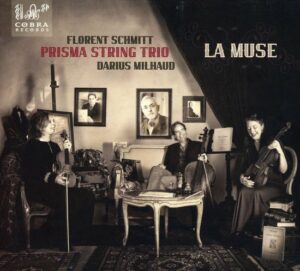

In dit artikel twee bijzondere albums waar klassieke werken zijn gearrangeerd voor trio. Het LINOS Piano Trio speelt op Stolen Music werk van Debussy, Dukas, Schönberg en Ravel. Het Prisma String Trio horen we op La Muse met een compositie van Schmitt en Milhaud.
English version below
Het spelen van covers, bewerkingen of arrangementen is binnen de pop- en jazz-muziek (standards) veel gebruikelijker dan bij het klassieke repertoire. Vanaf de Barok (begin 17de eeuw) moest de musicus steeds nauwgezetter de partituur volgen. Zowel in het gebruik van instrument, als ook in speelwijzen waar tempi, sforzato, legato, pizzicato etc. steeds dwingender moesten worden opgevolgd. Zo klonk er wat de componist had bedoeld, niet alleen qua speelwijzen maar zeker ook qua timbre. (bijvoorbeeld het gebruik van de viool in Prelude a apres-midi d’un faune, dat oorspronkelijk door de dwarsfluit wordt gespeeld). Maar toch is er een algehele lichte kentering merkbaar waar vakkundige arrangeurs zich wagen aan bekend klassiek repertoire. Gitarist Larry Coryell die in zijn eentje L’ Oiseau De Feu (Firebird)/Petrouchka van Stravinsky speelt. Het Zwitsers ensemble Franui dat op zeer originele wijze werken van Mahler, Brahms en Schubert ten gehore brengt. En dan heb ik het nog niet gehad over de Pictures from an Exhibition (Moessorgski) dat door o.a. Emerson, Lake & Palmer richting pop- en rockmuziek werd getransformeerd, net zoals ’s lands meesterlijke groep Ekseption dat deed met werk van Saint-Seans of Beethoven. Daar kun je natuurlijk van alles van vinden, maar het brengt de muziek wel dichter bij een breed publiek dat hierdoor wellicht op zoek gaat naar andere (klassieke) werken.
Het LINOS Piano Trio (LPT) speelt op hun nieuwe album Stolen Music programmatische werken, programmamuziek. Composities met een verhaal die met zorg zijn gearrangeerd voor piano, cello en viool. In elk stuk is de muziek uitgekristalliseerd, teruggebracht naar de kern en klinken de noten die elementair zijn. Duidelijk te horen in Prelude a apres-midi d’un faune van Debussy. Een werk uit het impressionisme waar sfeer en klankkleur uiterst belangrijk zijn, voortreffelijk uitgevoerd door het LPT. Dat geldt overigens ook voor Verklärte Nacht van Arnold Schönberg. Een werk dat Schönberg schreef n.a.v. zijn verliefdheid op zijn latere vrouw Mathilde, met wie hij in 1901 trouwde. In deze ‘sobere’ bezetting komt dit fantastische werk eigenlijk nog beter tot zijn recht en wordt de sfeer subtiel weergegeven. De Tovenaarsleerling (L’apprenti sorcier) van Paul Dukas is een op muziek gezet sprookje waarbij de tovenaarsleerling gaat experimenteren. Dit gaat (natuurlijk) fout en hij breekt per ongeluk de dansende bezem. Nu gaan beide stukken dansen, gevolgd door een markant moment dat de tovenaar in de deuropening verschijnt. De uitvoering van het LPT behoudt de prachtig beeldende kracht die zo belangrijk is voor deze compositie. Deze drie musici geven de muziek de juiste dosis energie en lichtheid. Iets soortgelijks horen we ook in het slotwerk La Valse van Maurice Ravel. Een compositie die oorspronkelijk als ballet bedoeld was, maar in de uitvoering van het LPT zijn vederlichtheid en souplesse behoudt, met opmerkelijk spel van pianist Prach Boondiskulchok. Deze magistraal mooie CD Stolen Music zou ik liever Borrowed Music (Geleende Muziek) willen noemen, aangezien de bewerkers van het LPT en Eduard Steuermann (die V. Nacht arrangeerde) de kern van het repertoire nauwlettend vertaalden naar piano-trio en de muziek niet Stelen maar respectvol Lenen.
Het Nederlandse Prisma String Trio speelt heel ander, minder bekend, repertoire. Het trio bestaat uit viool, alt-viool en cello. Dit prachtige album La Muse opent met Trio à Cordes van Florent Schmitt (1870-1955). Deze compositie is geschreven voor strijktrio en is dus geen bewerking. Een doorwrochte compositie met een enorme strijkbreedte waar veel te halen is voor de oplettende luisteraar, die meer en meer genieten zal bij elke luisterbeurt. In dit 4-delige werk komt het aan op de kwaliteit van musici, die elkaar niet alleen moeten aanvoelen in klankkleur, maar ook in flexibiliteit, subtiliteit, kracht en dynamisch samenspel. Het Prisma String Trio speelt dit stuk met zo’n organisch gemak dat je bijna vergeet hoe ingenieus en moeilijk deze compositie is. Darius Milhaud was een componist uit de Group des Six. Een gezelschap dat zich afzette tegen de hoog-romantiek (Wagner, Mahler) en op zoek ging naar soberheid en melodie. Een stroming waar o.a. de fijnzinnige Francis Poulenc en Arthur Honegger ook toe behoorden. Op La Muse heeft het trio het mooiste voor het laatst bewaard: La Muse ménagèr. Een intiem werk van Darius Milhaud. Vijftien korte werkjes, veelal niet langer dan 1’5 minuut, opgedragen aan Madeleine, de vrouw van Milhaud die hem jarenlang verzorgde. Hij had een zwakke gezondheid en was van (haar) hulp afhankelijk. Deze oorspronkelijk voor piano geschreven composities zijn innemend en transparant bewerkt voor strijktrio door 4 verschillende musici. Elk deel heeft een eigen verhaal, een zelfstandig muzikaal poëtisch gedicht dat uitmuntend wordt uitgevoerd door het Prisma String Trio. Bij tijd en wijlen heb je zelfs het idee dat je meer strijkers hoort en dan er daadwerkelijk klinken. In veel kunstvormen is de Kunst van het weglaten een veel gehoord metier. Bij het Prisma String Trio lijkt de Kunst van het ‘metaforisch’ toevoegen meer op zijn plaats: en dat is echt een Kunst op zich!
English version
Two special albums where classical compositions are arranged for trio are the center of this article. The LINOS Piano Trio plays on their album Stolen Music works by Debussy, Dukas, Schönberg and Ravel. And the Prisma String Trio plays on La Muse with a composition by Schmitt and Milhaud.
Playing covers or arrangements is much more common in pop and jazz music (standards) than in the classical repertoire. From the Baroque period (early 17th century) the musician had to follow the score more and more closely. Both in the use of the instrument, as well as in the art of playing, where tempi, sforzato, legato, pizzicato etc. had to be followed more and more urgently. In this way the music sounded to what the composer had intended. Not only in terms of playing styles, but also in terms of timbre. For example, the use of the violin in Prelude a apres-midi d’un faune was originally played by the flute. Today there is a slight turnaround where skilled arrangers venture into well-known classical repertoire. Like guitarist Larry Coryell who played guitar solo the composition L’Oiseau De Feu (Firebird)/Petrouchka by Stravinsky. The Swiss ensemble Franui that performs works by Mahler, Brahms and Schubert in a very original way. And then I haven’t even mentioned the Pictures from an Exhibition (by Mussorgsky) that was transformed by Emerson, Lake & Palmer, among others, into pop and rock music. Just like the Dutch masterful group Ekseption. They played work by Saint-Seans or Beethoven. This way of making music brings the classical repertoire closer to a wider audience, who maybe get interested in other (classical) works.
The LINOS Piano Trio (LPT) plays program music on their new album Stolen Music. Compositions with a stor, carefully arranged for piano, cello and violin. In each piece the music is crystallized and reduced to the core and the notes that really matter. You can clearly hear it in Debussy’s Prelude a apres-midi d’un faune. A work from impressionism period where atmosphere and timbre are extremely important, excellently played by the LPT. This also applies to Verklärte Nacht by Arnold Schönberg. He wrote this composition in response to his infatuation with his later wife Mathilde, whom he married in 1901. In this ‘sober’ line-up, this fantastic work is subtle reproduced and actually it comes even in a better atmosphere than the original. The Sorcerer’s Apprentice (L’apprenti sorcier) by Paul Dukas is a fairy tale set to music in which the Sorcerer’s Apprentice starts experimenting. This (of course) went wrong and he accidentally breaks the dancing broom. Now both pieces start dancing, followed by a striking moment when the sorcerer appears in the doorway. The performance of the LPT retains the beautiful visual power that is so important in this composition. These three musicians give the music the right dose of energy and lightness. We also hear something similar in the closing work La Valse by Maurice Ravel. A composition that was originally intended as a ballet, but in the performance of the LPT retains its feather light and suppleness, with remarkable playing by pianist Prach Boondiskulchok. I would prefer to call this masterfully beautiful CD Stolen Music – Borrowed Music, since the arrangers of the LPT and Eduard Steuermann (who arranged V. Nacht) carefully translated the core of the repertoire to piano trio and did not steal the music, but borrow it with respect. Excellent album!
The Dutch Prisma String Trio plays a very different, less known, repertoire. The trio consists of violin, viola and cello. This beautiful album La Muse opens with Trio à Cordes by Florent Schmitt (1870-1955). This composition is written as a string trio and is therefore not an arrangement. A well-thought-out composition with an enormous range. There is much to explore for the attentive listener, who will get more and more intersted after a few times listening. These three musicians feel the timbre, the flexibility and subtlety of the music which they explore in their powerful and dynamic interplay. The Prisma String Trio plays this piece with such organic ease that you almost forget how ingeniously difficult this composition is. Darius Milhaud was a composer from the Group des Six. A composers society that rebelled against high romanticism (Wagner, Mahler) and went in search of sobriety and melody. A movement to which the delicate composers Francis Poulenc and Arthur Honegger also belonged. At La Muse, the trio saved the best for last. The final piece La Muse ménagèr is an intimate work, written by Darius Milhaud. Fifteen short compositions, mostly no longer than 1’5 minutes, dedicated to Madeleine, Milhaud’s wife, who cared for him for years. He was in poor health and dependent on (her) help. Originally written for piano, these compositions have been captivatingly and transparently arranged for string trio by 4 different arrangers. Each part caries its own story, an independent musical poetic poem that is performed superbly by the Prisma String Trio. Now and then you even have the idea that you listening to more strings than there actually sound. In many art forms, the Art of omission is a frequently heard metier. With the Prisma String Trio it is the Art of seemingly adding. That’s really an Art of its own!
- Linos Piano Trio: Stolen Music (Avi-Music / Challenge Records)
- Prisma String Trio: La Muse (Cobra Records)
- Foto Prisma String Trio – Maaike Eijkman.
© Mattie Poels.

Geen reacties